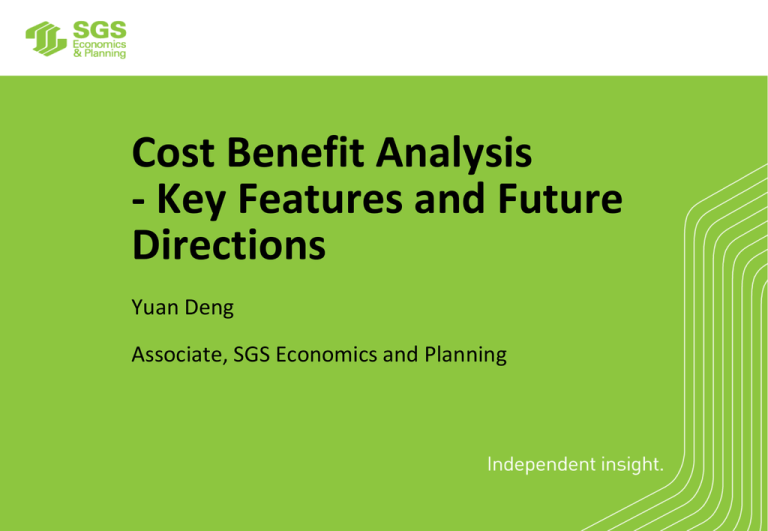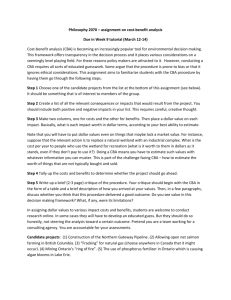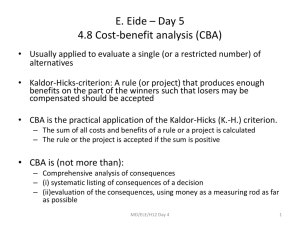Cost Benefit Analysis - Key Features and Future Directions
advertisement

Cost Benefit Analysis - Key Features and Future Directions Yuan Deng Associate, SGS Economics and Planning Overview •What is cost benefit analysis (CBA)? •What are its key features? •Failings of cost benefit analysis •Where to from here with CBA 2 What is CBA? • An investment in a project effectively generates two types of benefits: • Those captured ‘internally’ – by the investor as revenues • Those that accrue to the wider public, often referred to as ‘positive externalities’ • Many of the positive externalities are not traded, but they underpin the merits of and why we undertake public projects. • There needs to be a means of evaluating them to make informed decisions about investment in a given project. 3 As an economic evaluation method • CBA is the most commonly accepted technique for evaluating public policies and investments • First applied by government to evaluate water projects in the UK in 1936 (Ackerman 2008). • Has been used by the World Bank (1996) for over 40 years • The power of CBA rests in two main features: • Costs and benefits are, as far as possible, expressed in monetary terms • Costs and benefits are measured from the perspectives of all individuals in a community, rather than any particular party 4 Key features • First is the need to identify a ‘without’ project scenario, and one or multiple ‘with’ project scenarios. • Secondly it is necessary to identify the range of economic, social and environment costs and benefits that might be expected in moving from the ‘without’ to ‘with’ project scenarios. • Third is the quantification of costs and benefits • Often monetary values are available for capital cost and operational expenditure and revenue of the project • Proxy values need to be derived for the non-traded costs and benefits • Some of the established techniques include travel time method, shadow pricing and stated preference method 5 Key features • Costs and benefits are allocated over a suitable project evaluation period, typically 25 years. • Finally, performance measures are generated using discounted cash flow techniques over the project life. • Discounted to the present using a ‘discount rate’ - NSW Treasury recommends using a 7% discount rate with sensitivity tests of 4% & 10% • Main performance measures in CBA include NPV, BCR and IRR • Focuses on net community benefit – deemed worthy of investment if the beneficiaries ‘compensate’ the losers and still remain in positive territory. 6 Limitations of CBA Those stemming from a poor application of technique include the following: • The difficulty of quantifying non-traded costs and benefits • False accuracy • Equity overlooked • A robust CBA should not ‘overreach’ !! 7 Limitations of CBA More systematic weakness particularly for major city shaping investments: • Limited to ‘first round’ impacts – indirect and feedback effects are excluded • Inappropriately discounting the future • Applying a discount rate to increasingly valued future benefits – perhaps lower discount rates should be applied to intergenerational values. 8 Clearly the CBA technique conventionally applied would not be able to incorporate the long term benefits such as what the Harbour Bridge has delivered. Taken by Rodney Haywood 9 Conclusion • CBA has played a critical role in public policy for more than 50 years now • Correctly applied, CBA is a rigorous technique for evaluating projects competing for limited public sector resources. • However, it’s critical to recognise its limitations • E.g. the relatively narrow focus of CBA on first round effects limits its capability of capturing the long term feedback effects of major city shaping projects 10 CBA needs to evolve further • Tracking long run effects, and linking this to land use outcomes • Deepening the research and evidence base to better quantify ‘intangibles’ • Using much lower discount rates for items which will demonstrably increase their value in future • A need for improved consistency in application across practitioners 11



